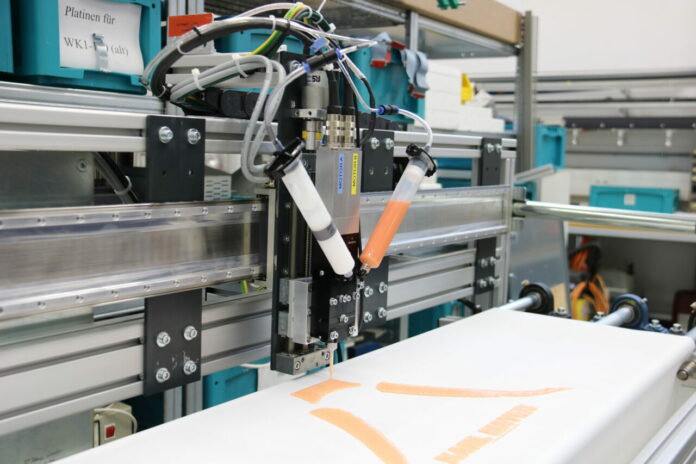KARL MAYER, a manufacturer that provides solutions for the fields of warp knitting and flat knitting, technical textiles, warp preparation for weaving and digitalisation, has merged additive manufacturing with the traditional procedures used in the textile industry to enable new potential for product development and new market opportunities. The solution combines the warp knitting machine with a 3D printing system in a homogenous process according to the roll-to-roll principle.
“3D printing allows us to completely rethink our whole approach to textile product design. The world of sportswear is already showing us what is possible. Mass-produced articles complete with 3D-printed branding and functional elements are already firmly established in this domain,” notes Michael Kieren from KARL MAYER’s New Business Development team. In addition, the carbon footprint of newly developed products is good, since savings are made on material and energy-intensive working steps. The new 3D inline printer really makes the most of its advantages, particularly when manufacturing prototypes and equipping of textile products with reinforced areas as well as design or function elements for additional benefits.
Flowing process management
With the new 3D printing solution, the textile is printed directly after it has been manufactured on the warp knitting machine. This involves the machine directly communicating with the printer’s pattern system to enable targeted control. The inline printing head can be moved quickly to every necessary manufacturing position. It is mounted on an H-gantry and can be moved in all directions in space at a speed of 5 m/s. A camera system and a pattern recognition software ensure highest precision during positioning of the printing head on the 2×1 meter printing field.
The current printer version processes polyurethane and silicone without heat. The materials generally used in textile finishing are applied at a printing speed equivalent to a textile production of 85 m²/h with a warp knitting machine working width of 138″.
The new 3D printing table
The solution called, a 3D printing table, has been tested with Bielefeld University of Applied Science, KARL MAYER’s development partner, for the production of shoe cloths. “Here, even more than in other areas, a very wide variety of applications is required. The 3D printing table is ideal for this”, Michael Kieren concludes.
Remember, you can post jobopportunities in the AM Industry on 3D ADEPT Media free of charge or look for a job via our job board. Make sure to follow us on our social networks and subscribe to our weekly newsletter : Facebook, Twitter, LinkedIn & Instagram ! If you want to be featured in the next issue of our digital magazine or if you hear a story that needs to be heard, make sure to send it to contact@3dadept.com


